Ricoh PJ WX3340N, PJ WX4240N, PJ X3340N, PJ X4240N Owner's Manual
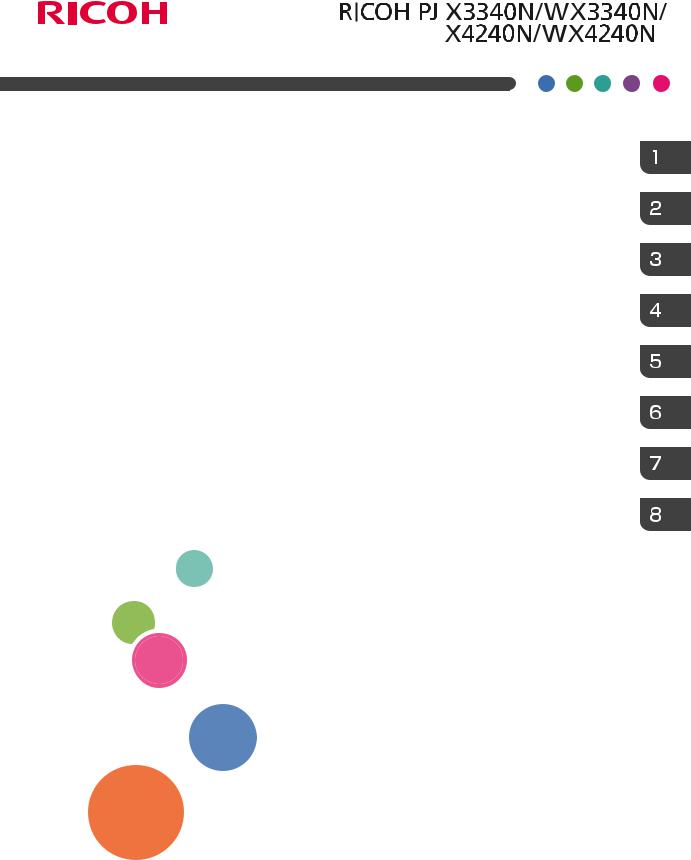
Operating Instructions
Preparations for Using the Projector
Projecting an Image
Projecting Images from a USB Memory Device or Digital Camera
Using the Projector via a Network
Changing the Projector Settings
Troubleshooting
Maintenance
Appendix
For safe and correct use, be sure to read the Safety Information in "Read This First" before using the machine.

TABLE OF CONTENTS |
|
Introduction......................................................................................................................................................... |
6 |
Copyrights to Images..................................................................................................................................... |
6 |
Important......................................................................................................................................................... |
6 |
Notes to Users Viewing 3D Images.............................................................................................................. |
6 |
Manuals Provided with the Projector................................................................................................................ |
8 |
Manuals for the Projector.............................................................................................................................. |
8 |
How to Read This Manual................................................................................................................................. |
9 |
Symbols........................................................................................................................................................... |
9 |
Notes............................................................................................................................................................... |
9 |
Model-Specific Information............................................................................................................................. |
10 |
1. Preparations for Using the Projector |
|
Main Functions................................................................................................................................................. |
11 |
Checking the Accessories................................................................................................................................ |
13 |
Projector Parts and Their Functions................................................................................................................. |
15 |
Exterior.......................................................................................................................................................... |
15 |
Ports on the Projector................................................................................................................................... |
16 |
Control Panel................................................................................................................................................ |
17 |
Remote Control Parts and Their Functions...................................................................................................... |
19 |
How to Use the Remote Control...................................................................................................................... |
22 |
Effective Range of the Remote Control....................................................................................................... |
22 |
Loading Batteries into the Remote Control................................................................................................. |
23 |
Inputting Text................................................................................................................................................ |
24 |
Operating a Computer with the Remote Control...................................................................................... |
24 |
Operating Multiple Projectors with the Remote Control........................................................................... |
25 |
Positioning the Projector................................................................................................................................... |
27 |
Projection Mode.......................................................................................................................................... |
27 |
Relationship Between the Projection Distance and the Screen Size........................................................ |
28 |
Connecting Equipment to the Projector.......................................................................................................... |
31 |
Connecting a Computer.............................................................................................................................. |
31 |
Connecting AV Equipment.......................................................................................................................... |
33 |
Connecting an External Display Device..................................................................................................... |
34 |
Connecting an External Speaker................................................................................................................ |
34 |
1

2. Projecting an Image |
|
Precautions for Using the Projector................................................................................................................. |
35 |
Basic Operations.............................................................................................................................................. |
37 |
Projecting an Image..................................................................................................................................... |
37 |
Turning Off the Projector............................................................................................................................. |
39 |
Adjusting the Projected Image........................................................................................................................ |
41 |
Adjusting the Angle of the Projection......................................................................................................... |
41 |
Changing the Size of the Projected Image................................................................................................ |
41 |
Adjusting the Focus...................................................................................................................................... |
43 |
Adjusting for Keystone Distortion................................................................................................................ |
44 |
Operations while Projecting Images............................................................................................................... |
46 |
Adjusting the Volume of the Speaker......................................................................................................... |
46 |
Enlarging the Image.................................................................................................................................... |
46 |
Temporarily Blanking the Image and Muting the Audio.......................................................................... |
47 |
Freezing the Image...................................................................................................................................... |
48 |
Specifying the Lamp Settings...................................................................................................................... |
48 |
Using the Presentation Timer....................................................................................................................... |
49 |
3. Projecting Images from a USB Memory Device or Digital Camera |
|
Requirements for Projecting Images from a USB Device.............................................................................. |
51 |
How to Project Images from USB Memory Device....................................................................................... |
53 |
Connecting the USB Device........................................................................................................................ |
53 |
Projecting Images from a USB Memory Device........................................................................................ |
53 |
Controlling the Projected Image................................................................................................................. |
54 |
Disconnecting the USB Device.................................................................................................................... |
55 |
Converting Presentation Files to JPEG Files Using JPEG Conversion Tool................................................... |
56 |
How to Use JPEG Conversion Tool............................................................................................................ |
56 |
Converting Presentation Files to JPEG Files................................................................................................ |
57 |
4. Using the Projector via a Network |
|
Before Connecting to a Network.................................................................................................................... |
59 |
Connecting an Ethernet Cable.................................................................................................................... |
59 |
Precautions for Using a Wireless LAN....................................................................................................... |
60 |
Connecting the Projector to a Network.......................................................................................................... |
62 |
Opening the [Network Setting Wizard] Screen........................................................................................ |
63 |
2

Configuring the Wired LAN Settings.......................................................................................................... |
63 |
Configuring the Wireless LAN Settings for Infrastructure Mode.............................................................. |
64 |
Configuring the Wireless LAN Settings for Ad Hoc Mode....................................................................... |
67 |
Projecting a Computer's Screen via a Network............................................................................................. |
68 |
How to Use QuickProjection....................................................................................................................... |
68 |
Projecting Images Using QuickProjection.................................................................................................. |
69 |
Using the Server Function................................................................................................................................ |
70 |
Using the Projection Server Function.......................................................................................................... |
71 |
Using the DLNA Server Function................................................................................................................ |
73 |
Projecting Files that Are Stored on the Server........................................................................................... |
73 |
Projecting Images Using DLNA-Compatible Devices................................................................................... |
76 |
Preparation................................................................................................................................................... |
76 |
Projecting Images from DLNA-Compatible Devices................................................................................. |
76 |
5. Changing the Projector Settings |
|
Viewing the Menu Screen............................................................................................................................... |
79 |
Using the Menu Screen................................................................................................................................... |
81 |
Restoring Settings to Their Default Settings.................................................................................................... |
83 |
Image Adjustment Menu.................................................................................................................................. |
84 |
Display Settings Menu..................................................................................................................................... |
87 |
Energy Saving Settings Menu......................................................................................................................... |
90 |
Default Settings 1 Menu.................................................................................................................................. |
93 |
Default Settings 2 Menu.................................................................................................................................. |
95 |
USB Settings Menu........................................................................................................................................... |
97 |
Settings.......................................................................................................................................................... |
97 |
Display Status............................................................................................................................................... |
98 |
Network Settings Menu................................................................................................................................... |
99 |
Wired LAN................................................................................................................................................... |
99 |
Wireless LAN (RICOH PJ X3340N/WX3340N/WX4240N only)................................................... |
100 |
LAN Common............................................................................................................................................ |
103 |
Projector ID................................................................................................................................................ |
105 |
Setup Wizard............................................................................................................................................ |
106 |
Display Status............................................................................................................................................ |
106 |
Network Application Settings Menu............................................................................................................ |
107 |
3

Administration Tools.................................................................................................................................. |
107 |
Security....................................................................................................................................................... |
109 |
Server......................................................................................................................................................... |
110 |
Firmware Update....................................................................................................................................... |
112 |
Display Status............................................................................................................................................ |
112 |
Display Status................................................................................................................................................. |
113 |
6. Troubleshooting |
|
Indicator Display List...................................................................................................................................... |
115 |
Common Problems......................................................................................................................................... |
117 |
Accessing the Online Knowledge Base................................................................................................... |
121 |
7. Maintenance |
|
Operating Precautions.................................................................................................................................. |
123 |
Cleaning the Projector................................................................................................................................... |
125 |
Cleaning the Lens...................................................................................................................................... |
125 |
Cleaning the Projector.............................................................................................................................. |
125 |
Replacing the Lamp....................................................................................................................................... |
127 |
Managing the Projector Using Projector Management Utility................................................................... |
133 |
Installing Projector Management Utility................................................................................................... |
133 |
Settings Required to Use Projector Management Utility........................................................................ |
134 |
Starting Projector Management Utility..................................................................................................... |
134 |
Managing the Projector Using Web Image Monitor.................................................................................. |
136 |
Displaying Web Image Monitor.............................................................................................................. |
136 |
About Browse Mode and Edit Mode...................................................................................................... |
137 |
Login to Edit Mode.................................................................................................................................... |
138 |
Controlling and Monitoring the Projector Using Crestron RoomView....................................................... |
139 |
Displaying Crestron WebUI..................................................................................................................... |
139 |
Using Crestron WebUI.............................................................................................................................. |
140 |
Consumables.................................................................................................................................................. |
143 |
8. Appendix |
|
Specifications for the Projector..................................................................................................................... |
145 |
List of Compatible Signals............................................................................................................................. |
149 |
Video Input................................................................................................................................................. |
149 |
Y/Pb/Pr Input............................................................................................................................................ |
149 |
4

Computer Input.......................................................................................................................................... |
150 |
HDMI Input................................................................................................................................................ |
151 |
3D Format.................................................................................................................................................. |
152 |
Specifications for Ports.................................................................................................................................. |
154 |
Computer1 In Port and Computer2 In/Monitor Out Port...................................................................... |
154 |
Control Port................................................................................................................................................ |
155 |
Information..................................................................................................................................................... |
157 |
Copyrights.................................................................................................................................................. |
157 |
Updating the Firmware............................................................................................................................. |
157 |
Where to Inquire....................................................................................................................................... |
157 |
Trademarks..................................................................................................................................................... |
158 |
INDEX........................................................................................................................................................... |
161 |
5

Introduction
Copyrights to Images
When projecting images using the projector, be careful not to infringe the copyright of protected materials.
The following are examples that may infringe the copyright of protected materials.
•Broadcasting images or movies for commercial purposes
•Modifying images or movies using functions such as freeze, magnify, or zoom to broadcast images for commercial purposes or public viewing
•Varying the aspect ratio of images or movies using a function that changes the screen size to broadcast images for commercial purposes or public viewing
Important
In no event will the company be liable for direct, indirect, special, incidental, or consequential damages as a result of handling or operating the machine.
The manufacturer shall not be responsible for any damage or expense that might result from the use of parts other than genuine parts from the manufacturer with your office products.
Notes to Users Viewing 3D Images
Pay attention to the following points when viewing images using 3D glasses with the projector:
•You need 3D glasses to view 3D images. The projector uses DLP Link technology to synchronize with 3D glasses. You need to use the optional 3D glasses that support DLP Link (RICOH PJ 3D Glasses Type 2).
•How 3D images are viewed may vary according to the individual.
•Do not use 3D glasses for viewing any material other than 3D images.
•Before viewing 3D images, make sure to read the manuals provided with your 3D glasses and 3D compatible content.
•Avoid viewing 3D images for a long period of time. Take a break of 15 minutes or longer after every hour of viewing.
•If you feel sick while viewing 3D images, stop viewing them. If you continue to feel sick, consult a doctor.
6

•When viewing 3D images in a room where an LED lighting system or fluorescent lights are used, you may feel that the light in the room flickers. If this is the case, dim the lights until you do not notice any flickers, or turn off the lights.
•If you or any member of your family has a history of light-sensitive seizures, consult a doctor before viewing 3D images.
•To view 3D images, sit in front of the screen so that your eyes are parallel and level with the screen.
•Viewing 3D images from a place that is too close to the screen may result in eye strain. The distance between the screen and you should be at least three times the height of the screen.
•Adult supervision is required for children using 3D glasses.
•Viewing 3D images is not recommended for children under 6 years old. It may negatively affect development of their vision. Consult a doctor before using 3D glasses.
7
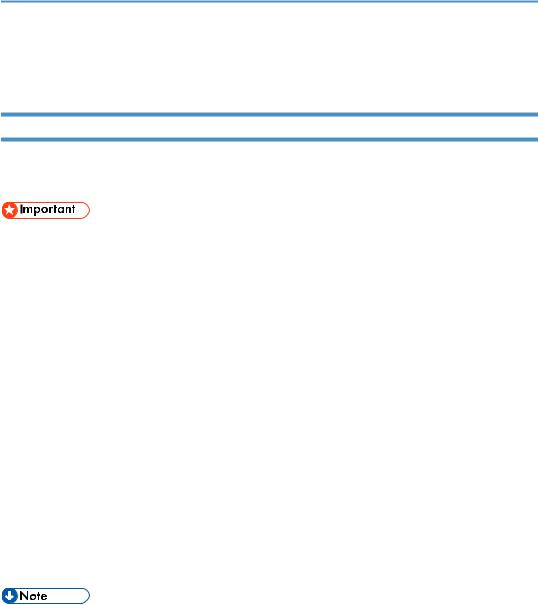
Manuals Provided with the Projector
Manuals for the Projector
Read this manual carefully before you use the projector.
Refer to the manuals that are relevant to what you want to do with the projector.
•The manuals are provided in various formats.
•Adobe® Acrobat® Reader®/Adobe Reader must be installed in order to view the manuals as PDF files.
Read This First
Provides information about safe usage of the projector.
To avoid injury and prevent damage to the projector, be sure to read the section of this manual entitled Safety Information.
Start Guide
Provides basic information about how to install the projector and how to project images. Since the contents of this manual are a summary of Operating Instructions, see Operating Instructions for detailed information.
Operating Instructions


Provide information about how to install the projector, how to project images using the projector, and how to configure the projector. It also provides information about troubleshooting and maintenance.
The CD-ROM includes only the English manual. For other languages, download the latest version from the Web site.
• The following software products are referred to using general names:
Product name |
General name |
|
|
RICOH JPEG Conversion Tool Type A |
JPEG Conversion Tool |
|
|
8
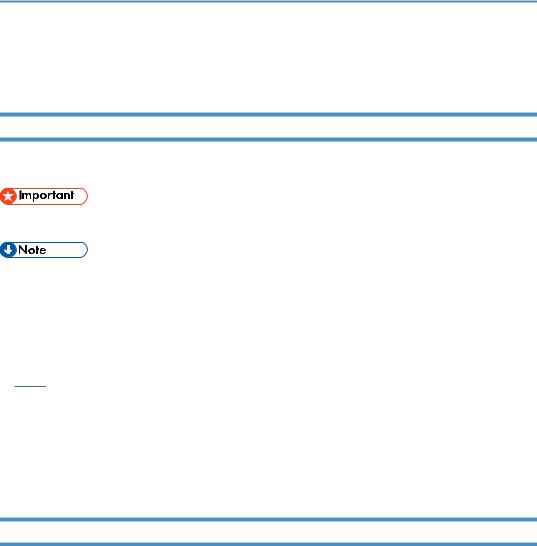
How to Read This Manual
Symbols
This manual uses the following symbols:
Indicates points to pay attention to when using the projector.
Indicates supplementary explanations of the projector’s functions, and instructions on resolving user errors.
[ ]
Indicates the names of buttons on the control panel and remote control. It also indicates items displayed on the menu screens.




 (mainly Europe and Asia)
(mainly Europe and Asia)




 (mainly North America)
(mainly North America)
Differences in the functions of Region A and Region B models are indicated by two symbols. Read the information indicated by the symbol that corresponds to the region of the model you are using. For details about which symbol corresponds to the model you are using, see page 10 "Model-Specific Information".
Notes
Contents of this manual are subject to change without prior notice. Two kinds of size notation are employed in this manual.
Some illustrations in this manual might be slightly different from the machine.
Certain options might not be available in some countries. For details, please contact your local dealer.
Depending on which country you are in, certain units may be optional. For details, please contact your local dealer.
9
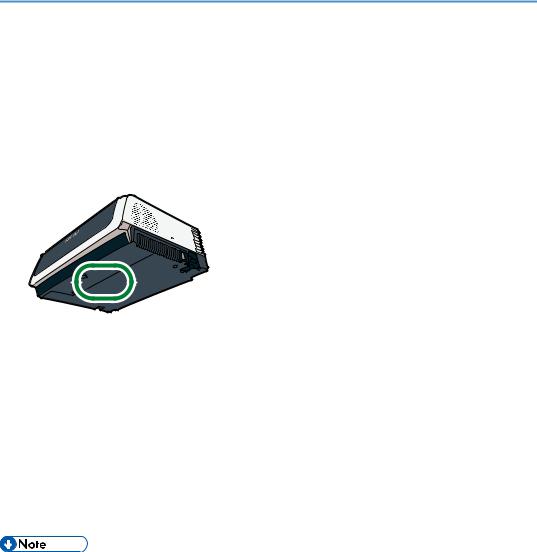
Model-Specific Information
This section explains how you can identify the region your projector belongs to.
There is a label on the bottom of the projector, located in the position shown below. The label contains details that identify the region your projector belongs to. Read the label.
CUD107
The following information is region-specific. Read the information under the symbol that corresponds to the region of your projector.




 (mainly Europe and Asia)
(mainly Europe and Asia)
If the label contains the following, your projector is a region A model:
• CODE XXXX -27




 (mainly North America)
(mainly North America)
If the label contains the following, your projector is a region B model:
•CODE XXXX -17
•Dimensions in this manual are given in two units of measure: metric and inch. If your projector is a Region A model, refer to the metric units. If your projector is a Region B model, refer to the inch units.
10

1. Preparations for Using the Projector
This chapter explains the names and functions of the different parts of the projector and remote control, and how to use them. It also explains how to position the projector and how to connect it to other equipment.
Main Functions
The projector features the following functions that you can use.
Auto eco function
The projector switches the lamp power automatically by detecting the brightness of the projecting location and image signals. This function is useful for energy saving.
Quick on
The projector starts projection automatically if the image signals are input even while in standby.
Auto keystone function
The projector automatically adjusts the shape of the projected image according to the angle at which the projector is positioned.
Automatic focus function (RICOH PJ X3340N/WX3340N only)
The projector automatically adjusts the focus when you turn on the projector and reposition it.
AV Mute/Freeze
Pressing the [AV Mute] button mutes the sound and blanks the screen. Pressing the [Freeze] button freezes the image temporarily.
Magnify/Zoom
Pressing the [Magnify] button enlarges the projected image. Pressing the [Zoom] button reduces the projected image.
Timer function
Pressing the [Timer] button displays the countdown timer on the projection screen. You can check the elapsed time on the projection screen.
Wall color mode
You can adjust the hue of the image in accordance with the color of the wall on which it is projected.
Password setting/Key lock
You can specify a password for the projector to limit the people that can use it. The buttons on the control panel can be disabled with the key lock setting to prevent misoperation.
11

1. Preparations for Using the Projector
Administrator authentication
Enable administrator authentication so that only the administrator can change the security settings. This improves the security of the projector because general users cannot change the settings.
User logo function
The projector can project a registered logo or image when there is no signal or when it is starting up.
Presentations without a computer
The projector can project JPEG and MPEG files stored on a USB memory device or a digital camera.
It is possible to convert PowerPoint materials to JPEG format using JPEG Conversion Tool and then project them using the projector.
Mouse remote control (RICOH PJ X3340N/WX3340N/WX4240N only)
You can operate the mouse pointer on a computer by using the remote control provided with the projector.
QuickProjection
QuickProjection is an application that is provided with the projector and is used for connecting the projector and a computer to project images.
12
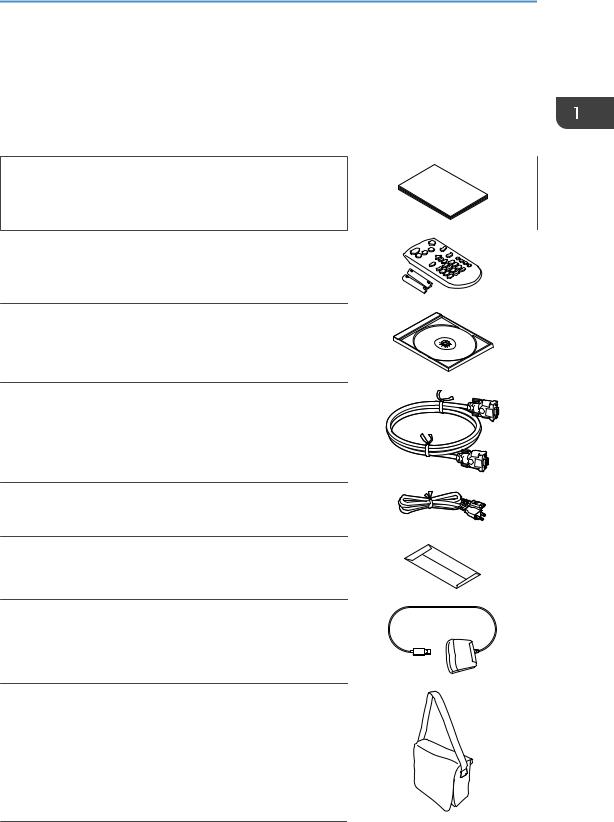
Checking the Accessories
Checking the Accessories
The projector is provided with the following accessories. Make sure that everything is included in the package.
If anything is missing or damaged, contact your sales representative or service representative.
Read This First
Start Guide
Remote control
AAA battery LR03
CD-ROM
RGB cable
Power cord
Warranty card
Mouse remote control receiver
(RICOH PJ X3340N/WX3340N/WX4240N only)
Carrying bag
(RICOH PJ X3340N/WX3340N only)
13

1.Preparations for Using the Projector
•The bundled accessories may vary depending on the location that this product was purchased.
•Use only the RGB cable and power cord provided with the projector.
•The various applications are on the provided CD-ROM. For instructions about using the applications, see page 56 "How to Use JPEG Conversion Tool", page 68 "How to Use QuickProjection", and page 133 "Managing the Projector Using Projector Management Utility".
14
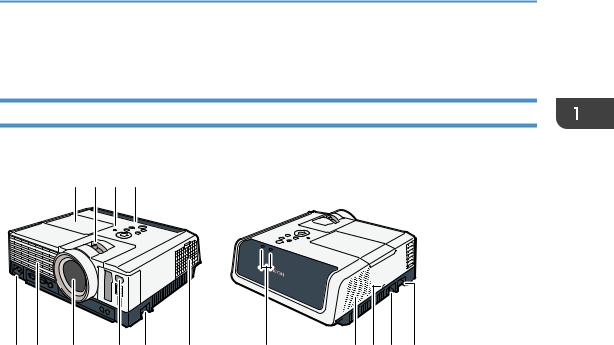
Projector Parts and Their Functions
Projector Parts and Their Functions
Exterior
The illustrations below depict the RICOH PJ X3340N/WX3340N.
1 2 3 4
5 |
6 |
7 |
8 |
9 |
10 |
11 |
12 |
13 |
14 |
9 |
|
|
|
CUD066 |
1.Lamp cover
Remove to replace the lamp.
2.Zoom lever/Focus lever
•Zoom lever (RICOH PJ X3340N/WX3340N) Adjusts the size of the projected image.
•Focus lever (RICOH PJ X4240N/WX4240N) Adjusts the focus of the projected image.
3.Illuminance sensor
Measures the brightness of the projecting location.
4.Control panel
See page 17 "Control Panel".
5.AC In socket
For connecting the power cord set provided with the projector.
6.Exhaust vents
Releases hot air from inside the projector.
7.Lens
Enlarges and projects the image (light).
8.Remote control receiver
Receives the signal from the remote control.
15
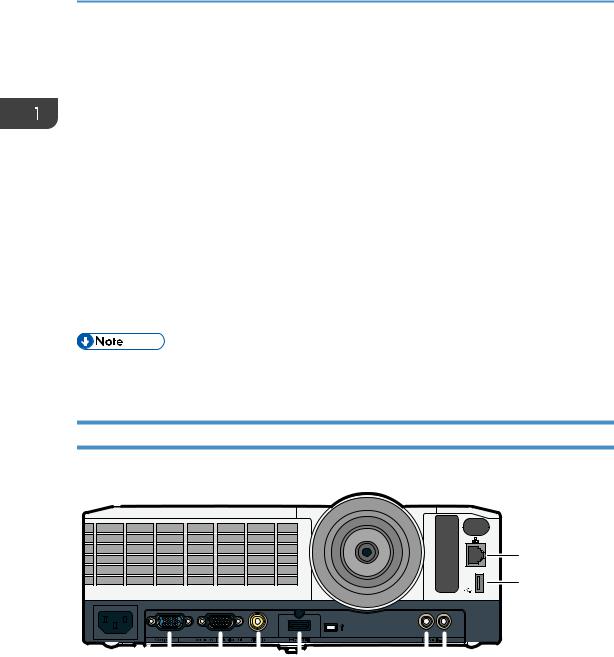
1.Preparations for Using the Projector
9.Adjustable feet
Adjusts the angle of the projection. Adjustable feet are located on the left and right sides on the projector.
10.Intake vents
For circulating air from the outside to cool the projector.
11.LED indicators
You can confirm the status of the projector by referring to the LED indicators. The left LED shows the status of the lamp, and the right LED shows the temperature inside the projector. For details, see page 115 "Indicator Display List".
12.Speaker
Outputs the audio input from an external device.
13.Security slot
For connecting an anti-theft cable.
14.Security bar
For connecting an anti-theft cable or chain.
•The top of the projector is covered with a protective film when it is shipped. Remove the film before using the projector.
Ports on the Projector
The illustrations below depict the RICOH PJ X3340N/WX3340N.
7
8
|
|
|
|
|
|
|
|
|
|
|
|
|
|
|
|
|
|
|
|
|
|
|
|
|
|
|
|
|
|
|
|
|
|
|
|
|
|
|
|
|
|
|
|
|
|
|
|
|
|
|
|
|
|
|
|
|
|
|
|
|
|
|
|
|
|
|
|
|
|
|
|
|
|
|
|
|
|
|
|
|
|
|
|
|
|
|
|
|
|
|
|
|
|
|
|
|
|
|
|
|
|
|
|
|
|
|
|
|
|
|
|
|
|
|
|
|
|
|
|
|
|
|
|
|
|
|
|
|
|
|
|
|
|
|
|
|
|
|
|
|
|
|
|
|
|
|
|
|
|
|
|
|
|
|
|
|
|
|
|
|
|
|
|
|
|
|
|
|
|
|
|
|
|
|
|
|
|
|
|
|
|
|
|
|
|
|
|
|
1 |
2 |
3 |
|
4 |
5 |
6 |
|
|
CUD063 |
|||||||||||||||||
|
|
|
|
|
|
|
|
|
|
|
|
|
|
|
|
|
|
|
|
|
|
|
|
|
|
|
1.Computer1 In port (Y/Pb/Pr)
For inputting RGB signals from a computer or component image signals (Y/Pb/Pr) from a video player.
2.Computer2 In/Monitor Out port
For inputting RGB signals, or outputting the image signals input into the "Computer1 In port" to an external display device. You can switch the purpose of this port in [Computer 2 Terminal] under [Default Settings 1].
16

Projector Parts and Their Functions
3.Video In port
For inputting image signals from a video player.
4.HDMI port
For inputting HDMI signals from a computer or video player.
5.Audio In port
For inputting audio signals from a computer or video player.
6.Audio Out port
For outputting audio signals to an external speaker.
7.LAN port
For connecting an Ethernet cable.
8.USB port
For connecting a USB memory device or USB device cable.
Control Panel
RICOH PJ X3340N/WX3340N RICOH PJ X4240N/WX4240N
1 |
|
|
2 |
|
|
3 |
6 |
6 |
4 |
7 |
|
5 |
|
|
CUD087
1.Arrow buttons
Used to operate the menu screen and the value bar. The [ ] and [
] and [ ] buttons are used to adjust the keystone distortion. The [
] buttons are used to adjust the keystone distortion. The [ ] and [
] and [ ] buttons are used to adjust the volume.
] buttons are used to adjust the volume.
2.[Enter] button
Enters the selected item or mode.
3.[Menu] button
Displays the menu screen. Press it again to close the menu screen.
4.[Input] button
Switches the signal input. The input signal changes each time the button is pressed.
17

1.Preparations for Using the Projector
5.[Power] button
Turns the projector on and off. You can confirm the status of the projector with the indicator.
•On: Power is on.
•Off: Power is off.
•Flashing at 1 or 3 second intervals: Standby.
•Flashing at short intervals: Starting up or cooling.
6.[Focus] button/[Eco] button
•[Focus] button (RICOH PJ X3340N/WX3340N)
Adjusts the focus manually. Press it, and then adjust the focus using the [ ] and [
] and [ ] buttons.
] buttons.
•[Eco] button (RICOH PJ X4240N/WX4240N)
Displays the [Energy Saving Settings] screen. On the [Energy Saving Settings] screen, you can specify the energy saving settings for the lamp.
7.[AV Mute] button
Temporarily blanks the screen and mutes the audio. The button lights up blue when the projector is muted.
18
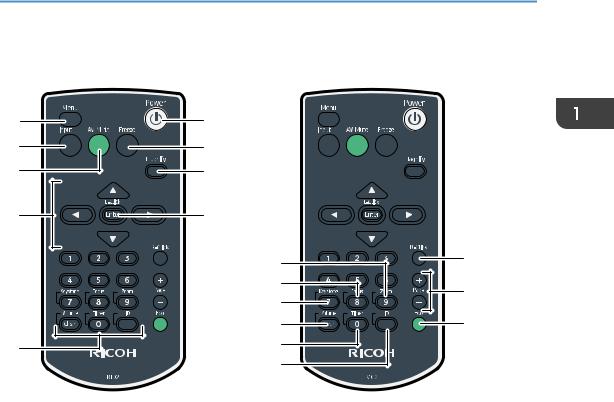
Remote Control Parts and Their Functions
Remote Control Parts and Their Functions
1 |
6 |
|
2 |
7 |
|
3 |
8 |
|
4 |
9 |
|
|
10 |
16 |
|
|
|
|
11 |
17 |
|
12 |
|
|
|
|
|
13 |
18 |
5 |
14 |
|
|
15 |
|
|
|
CUD050 |
1.[Menu] button
Displays the menu screen. Press it again to close the menu screen.
2.[Input] button
Switches the signal input. The input signal changes each time the button is pressed.
3.[AV Mute] button
Temporarily blanks the screen and mutes the audio. For details, see page 47 "Temporarily Blanking the Image and Muting the Audio".
4.Arrow buttons
Used to operate the menu screen and the value bar.
5.Number buttons
Used to enter numbers.
6.[Power] button
Turns the projector on and off.
7.[Freeze] button
Temporarily freezes the image. For details, see page 48 "Freezing the Image".
8.[Magnify] button
Displays the magnification ratio bar. Press it, and then specify the magnification ratio using the [ ] and [
] and [ ] buttons. For details, page 46 "Enlarging the Image".
] buttons. For details, page 46 "Enlarging the Image".
19

1.Preparations for Using the Projector
9.[Enter] button
Enters the selected item or mode.
10.[Zoom] button
Displays the digital zoom bar. Press it, and then adjust the size of the projected image using the [ ] and [
] and [ ] buttons. For details, see page 42 "Reducing the size of the projected image".
] buttons. For details, see page 42 "Reducing the size of the projected image".
11.[Focus] button
•RICOH PJ X3340N/WX3340N
Adjusts the focus manually. Press it, and then adjust the focus using the [ ] and [
] and [ ] buttons. For details, see page 43 "Adjusting the focus of RICOH PJ X3340N/WX3340N".
] buttons. For details, see page 43 "Adjusting the focus of RICOH PJ X3340N/WX3340N".
•RICOH PJ X4240N/WX4240N This button is not used.
12.[Keystone] button
Displays the keystone adjustment bar. Press it, and then adjust the keystone distortion using the [ ] and [
] and [ ] buttons. For details, page 44 "Adjusting for Keystone Distortion".
] buttons. For details, page 44 "Adjusting for Keystone Distortion".
13.[Volume] button
Displays the volume control bar. Press it, and then adjust the volume of the speaker using the [ ] and [
] and [ ] buttons. For details, see page 46 "Adjusting the Volume of the Speaker".
] buttons. For details, see page 46 "Adjusting the Volume of the Speaker".
14.[Timer] button
Displays the presentation timer. For details, see page 49 "Using the Presentation Timer".
15.[ID] button
Registers the remote control ID. For details, see page 25 "Operating Multiple Projectors with the Remote Control".
16.[R-Click] button
•RICOH PJ X3340N/WX3340N/WX4240N
Used to operate the computer with the remote control. It is the same as the right-click button on a mouse. This button can be used when the mouse remote control receiver is connected to a computer.
•RICOH PJ X4240N This button is not used.
17.[Page] buttons
•RICOH PJ X3340N/WX3340N/WX4240N
Changes the image while projecting images from a USB device or a projection server. Press [ ] to go to the next page. Press [ ] to go to the previous page.
] to go to the next page. Press [ ] to go to the previous page.
When the mouse remote control receiver is connected to a computer, these buttons can be used to change slides, such as in a PowerPoint presentation.
•RICOH PJ X4240N
Changes the image while projecting images from a USB device or a projection server. Press [ ] to go to the next page. Press [ ] to go to the previous page.
] to go to the next page. Press [ ] to go to the previous page.
20

Remote Control Parts and Their Functions
18.[Eco] button
Displays the [Energy Saving Settings] screen. On the [Energy Saving Settings] screen, you can specify the energy saving settings for the lamp. For details, see page 48 "Specifying the Lamp Settings".
21
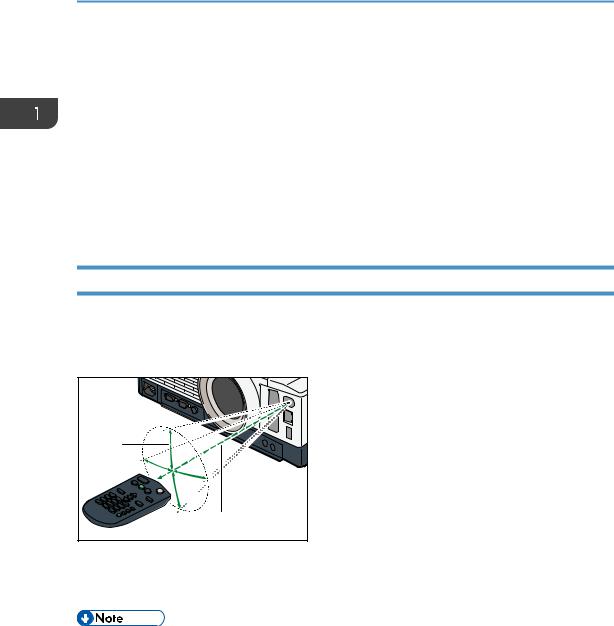
1. Preparations for Using the Projector
How to Use the Remote Control
You can use the remote control to turn the projector on and off, and to change the signal of the image being input and projected. You can also enlarge or reduce the image and mute the audio.
Note the following precautions when using the remote control:
•Do not drop or hit the remote control.
•Do not place the remote control in a place that is very hot or very humid.
•Do not get the remote control wet. Also, do not place it on anything that is wet.
•Do not dismantle the remote control.
Effective Range of the Remote Control
Point the remote control at the remote control receiver on the projector to use it.
The effective range of the remote control is about 5 meters (16.4 feet) from the receiver and at an angle of about 15 degrees to the remote control receiver on the projector.
2 |
1 |
CUD071 |
1.Distance: up to 5 meters (16.4 feet)
2.Angle: within 15 degrees
•The remote control may not be effective in some areas and in some conditions. If this happens, point the remote control at the projector and try it again.
•The remote control may not work if the remote control receiver on the projector is exposed to sunlight, fluorescent light, or strong light.
•You can use the remote control from behind the projector by reflecting the signal off of the screen. However, the effective range may change depending on the shape and material of the screen.
22
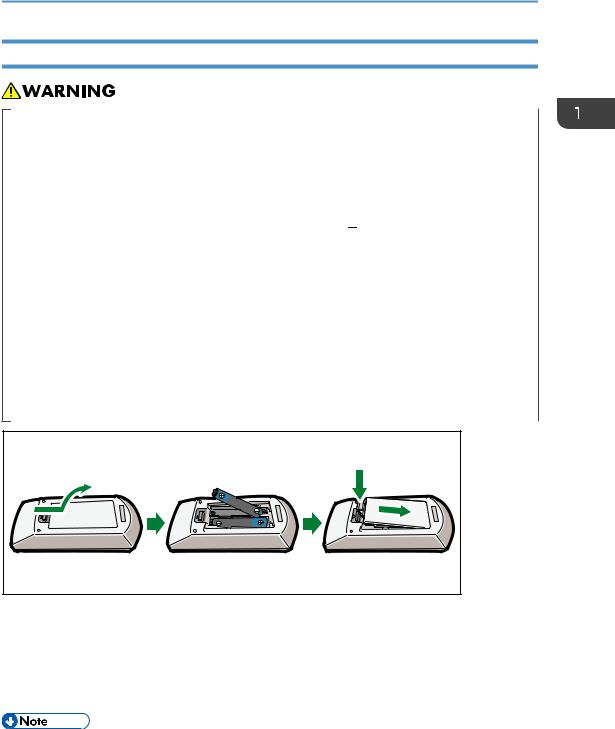
How to Use the Remote Control
Loading Batteries into the Remote Control
•For safe operation, follow the warnings below regarding the batteries used in the remote control. If you use the batteries incorrectly, it may result in fire or injury due to batteries leaking or exploding.
•Do not use batteries other than the ones specified.
•Do not mix and use batteries that are different types or that are new and old.
• Correctly insert batteries according to the polarity ( / ).
/ ).
•Do not charge non-rechargeable batteries.
•Do not heat or throw the batteries into fire or water.
•Do not connect the positive and negative terminals on a battery with a wire.
•Remove the batteries from the remote control that are past their suggested use period or that are depleted.
•Remove the batteries when they will not be used for extended periods.
•Keep the batteries out of the reach of children. Children may swallow or choke on the batteries. If this happens, contact a doctor immediately.
1 |
2 |
3 |
|
|
CUD092 |
1.Remove the battery cover from the remote control.
2.Insert the batteries.
Note the direction of the positive and negative terminals when inserting the batteries.
3.Close the battery cover.
•Replace the batteries if the remote control does not work or if the effective distance becomes too narrow.
23
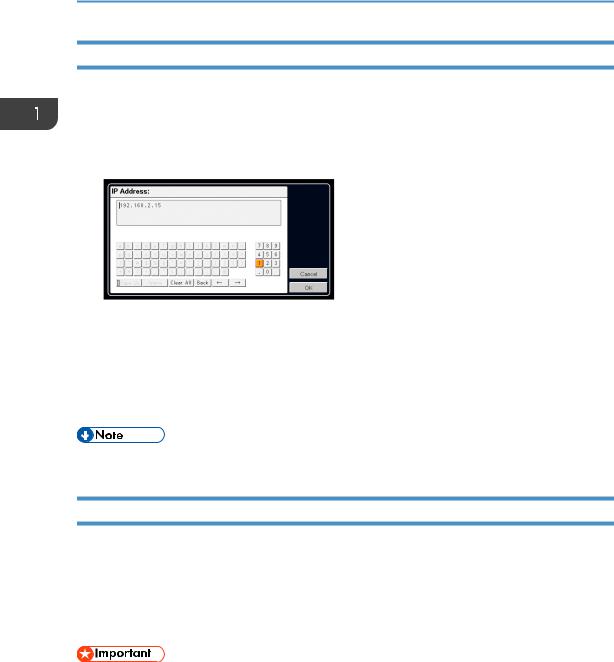
1. Preparations for Using the Projector
Inputting Text
Use the keyboard that is displayed on screen to input text on the setting screen.
1.Use the [ ], [
], [ ], [
], [ ], and [
], and [ ] buttons on the remote control to select a character on the screen.
] buttons on the remote control to select a character on the screen.
The selected character is highlighted in orange.
2.Press the [Enter] button.
The selected character appears in the text area.
3.After inputting all the characters, select [OK].
4.Press the [Enter] button.
The text is input.
• You can also use the number buttons on the remote control to input numbers.
Operating a Computer with the Remote Control
You can operate a computer using the projector's remote control. This function can be used when the mouse remote control receiver is connected to a computer.
This function is available with RICOH PJ X3340N/WX3340N/WX4240N.
A computer with a USB port that supports USB 2.0 can be used. Supported operating systems are Windows XP, Vista, and 7.
•Connect the mouse remote control receiver to a computer only when operating the computer with the remote control. When operating the projector with the remote control while the mouse remote control receiver is connected to the computer, the pointer on the computer screen also moves according to the key operations of the remote control.
1. Connect the mouse remote control receiver to the computer.
24
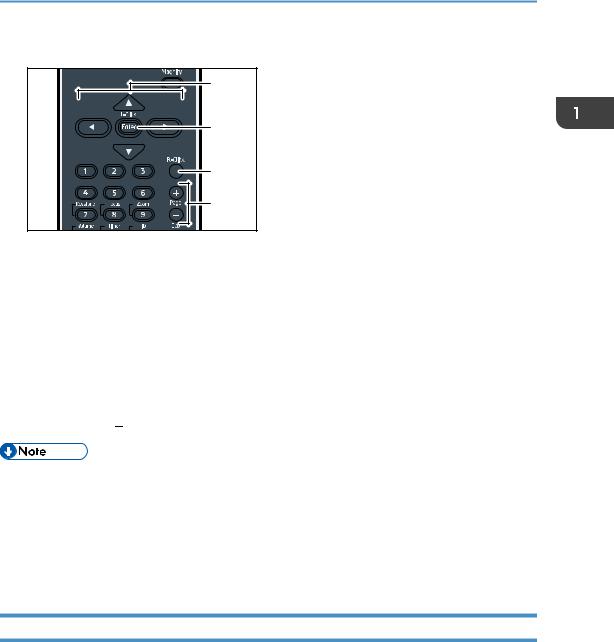
How to Use the Remote Control
2. Point the remote control at the mouse remote control receiver and press the buttons.
1
2
3
4
CUD085
1.Arrow buttons
Moves the mouse pointer. Press the button that corresponds to the direction you want to move the pointer.
2.[Enter] button
Left clicks.
3.[R-Click] button
Right clicks.
4.[Page] buttons
The [ ] and [ ] buttons change the pages in a PowerPoint presentation.
] and [ ] buttons change the pages in a PowerPoint presentation.
•Some computers cannot be operated using the projector's remote control.
•The remote control may not work if the mouse remote control receiver is exposed to sunlight, fluorescent light, or strong light. If this happens, change the position or orientation of the mouse remote control receiver.
•To drag-and-drop, hold down the [Enter] button while moving the pointer with the arrow buttons, and then release the button at the targeted location.
Operating Multiple Projectors with the Remote Control
You can operate multiple projectors with a single remote control. It is possible to operate a maximum of four projectors.
You need to specify an ID number to assign to each projector in [Remote Control ID] under [Default Settings 2] in advance.
25
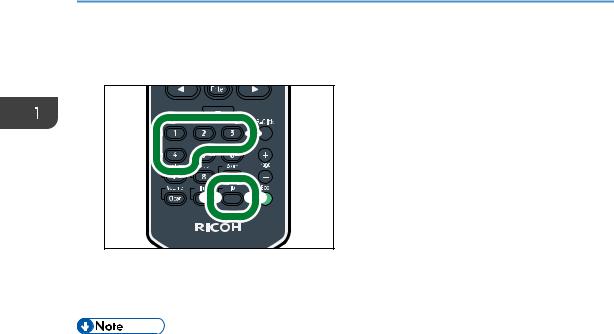
1.Preparations for Using the Projector
1.Press and hold the [ID] button and then press a number button from 1 to 4 for at least three seconds.
CUD086
The ID number assigned to the remote control is changed to the number you pressed.
2. Operate the projector.
•The remote control cannot operate a projector unless the ID on the remote control is the same as the controller ID specified in [Default Settings 2].
•The ID number specified in the remote control is effective until a different ID number is specified.
•The ID number in the remote control must be specified again if the batteries are changed.
26
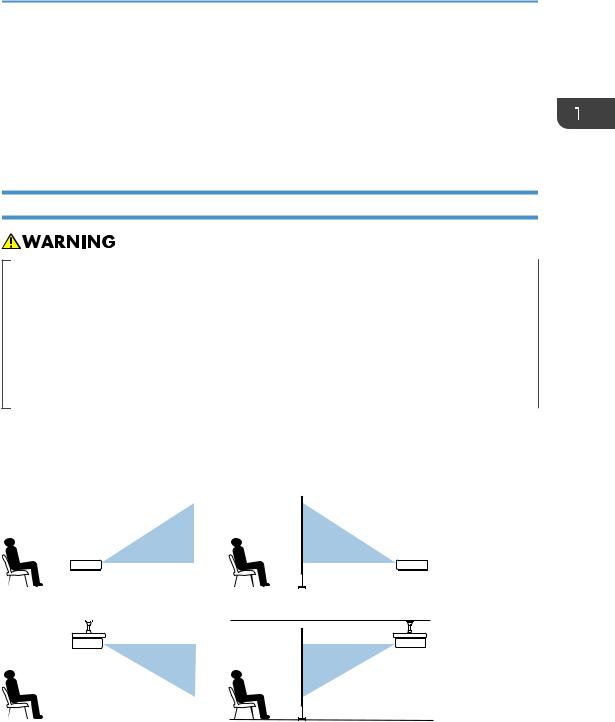
Positioning the Projector
Positioning the Projector
When positioning the projector, place it so that the projector's lens faces the screen. Make sure the projector and the screen are parallel to each other.
Adjust the distance between the projector and the screen according to the size of the projected image. For details, see page 28 "Relationship Between the Projection Distance and the Screen Size".
Projection Mode
•If a projector is incorrectly installed on a wall or ceiling, it may fall down and cause an injury. Contact your sales or service representative if you want to install a projector on a wall or ceiling.
•Use brackets that are strong enough to support the projector. The projector weighs about 3.1 kg (6.9 lb.).
•The projector must be installed in a location that is sturdy enough to support the full weight of the projector and brackets.
You can position the projector in one of four ways.
Select the setting according to the position of the projector in [Projection Mode] under [Default Settings 2]. For details, see page 95 "Default Settings 2 Menu".
1. Standard |
|
2. Rear |
|
||||
|
|
|
|
|
|
|
|
|
|
|
|
|
|
|
|
|
|
|
|
|
|
|
|
|
3. Ceiling |
|
4. Rear Ceiling |
||
|
|
|
|
|
|
|
|
|
|
|
|
|
|
|
|
|
|
CUD083
1.Standard
The projector is placed in front of a screen onto which the images are projected.
27
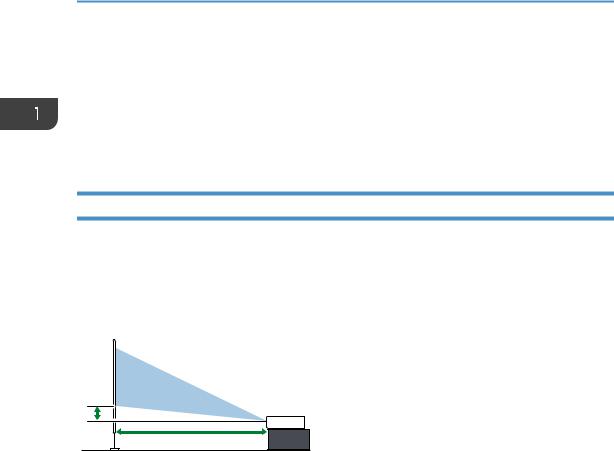
1.Preparations for Using the Projector
2.Rear
The projector is placed behind a screen onto which the images are projected.
3.Ceiling
The projector is mounted on the ceiling in front of a screen onto which the images are projected.
4.Rear Ceiling
The projector is mounted on the ceiling behind a screen onto which the images are projected.
Relationship Between the Projection Distance and the Screen Size
The size of the projected image varies according to the distance from the projector to the screen.
Refer to the following tables to position the projector in a suitable position. The projection sizes presented in tables are for a full size image without keystone adjustment. The projection distance becomes shortest when the zoom lever is at the end of the wide side, and longest when the zoom lever is at the end of the tele side.
b |
a |
CUD072 |
RICOH PJ X3340N
|
|
a |
b |
|
Projection size |
Projection distance |
|||
Projection height |
||||
|
Shortest |
Longest |
||
|
|
|||
|
|
|
|
|
30 inches |
0.68 m (2.22 feet) |
1.05 m (3.45 feet) |
4 cm (1 inch) |
|
|
|
|
|
|
40 inches |
0.92 m (3.02 feet) |
1.41 m (4.64 feet) |
5 cm (2 inches) |
|
|
|
|
|
|
60 inches |
1.40 m (4.58 feet) |
2.13 m (6.99 feet) |
7 cm (3 inches) |
|
|
|
|
|
|
80 inches |
1.87 m (6.12 feet) |
2.86 m (9.38 feet) |
10 cm (4 inches) |
|
|
|
|
|
|
100 inches |
2.34 m (7.68 feet) |
3.58 m (11.75feet) |
12 cm (5 inches) |
|
|
|
|
|
|
120 inches |
2.82 m (9.24 feet) |
4.31 m (14.12 feet) |
14 cm (6 inches) |
|
|
|
|
|
|
150 inches |
3.54 m (11.60 feet) |
5.39 m (17.67 feet) |
18 cm (7 inches) |
|
|
|
|
|
|
200 inches |
4.73 m (15.50 feet) |
7.20 m (23.61 feet) |
24 cm (9 inches) |
|
|
|
|
|
|
28
